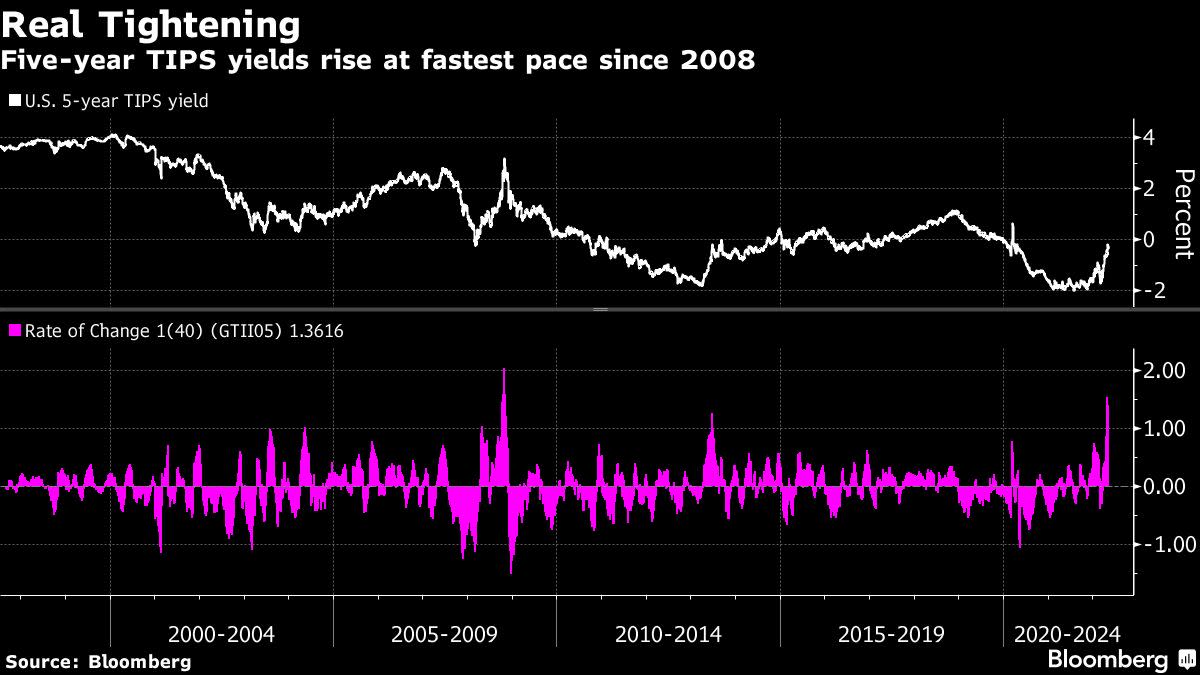Plenty of Catalysts to Help Push Treasury Rates Above 2018 Highs

(Bloomberg) — The relentless bear market in U.S. Treasury debt is on the cusp of a new phase, with yields across much of the maturity spectrum on course to crack above their 2018 highs and several major potential catalysts to help such a move.
Most Read from Bloomberg
Center stage will be April consumer price inflation on Wednesday, forecast to ebb from March rates that were the highest since 1982. Federal Reserve officials, who raised rates by a half point this week and set a June 1 date to begin reducing holdings of Treasuries, will be out in force discussing their approach to inflation. Meanwhile, the Treasury’s biggest month of debt sales for the May-to-July financing quarter kicks off with auctions of 3-, 10- and 30-year debt.
Even if none of those provides a logical impetus for higher yields, liquidity has deteriorated, making the Treasury market more susceptible to big shifts. Bloomberg’s US Government Securities Liquidity Index, which measures the average yield error for notes and bonds maturing in at least a year, approached its highest level of the year Friday. The two-year yield’s range exceeded 25 basis points for the third time this year on the day of the Fed meeting.
“This is a once-in-decade moment in capital markets,” said James Camp, director of fixed-income at Eagle Asset Management. Correlations are rising and “cross-asset volatility is incredible. We have nowhere to hide.”
A weekly survey of Treasury investors by JPMorgan Chase & Co. this week found a historically high level of risk-avoidance; neutral positioning was at its highest level since March 2020.
The surge in yields was led by real, or inflation-protected, notes and bonds, an indication that tightening financial conditions rather than inflation expectations were the primary driver. It accompanied steep declines for U.S. equities that sent the Standard & Poor’s 500 Index to the lowest level in nearly a year.
For shorter-maturity Treasuries like two- and five-year notes, exceeding the 2018 highs would mean returning to levels last seen before the 2008 financial crisis. For the benchmark 10-year, its 2018 peak of 3.25% was the highest level since 2011.
The two-year yield this week peaked at 2.85%, within 26 basis points of its 2018 high. The five-year reached 3.08%, two basis points from 2018 levels. The 10-year yield’s 19-basis-point increase to 3.13% was overshadowed, though, by the 27-basis-point increase in the 10-year inflation-protected yield, from just below 0% a week earlier.
The real yields on Treasury Inflation-Protected Securities have climbed as the Fed’s posture has bolstered confidence that rates in consumer price growth have peaked. Five-year TIPS yields rose more than 150 basis points in 40 trading days through May 3, the fastest pace since 2008.
The April CPI report is expected to show an overall decline in the annual pace of inflation to 8.1% from 8.5% in March. For core prices, which exclude food and energy, a drop to 6% from 6.5% is forecast.
Fed policy makers, in their statement announcing this week’s rate move — the first half-point increase since 2000 — said they were “highly attentive to inflation risks.” And while short-term interest-rate markets are priced for the policy rate to rise to 3.25% next year from the current range of 0.75% to 1%, it’s not clear how their course may be influenced by the lagged effects of tightening on the economy. Already, U.S. fixed 30-year mortgage rates have climbed to 5.27%, their highest point since 2009.
The latest phase of the selloff steepened the Treasury yield curve as long-dated rates rose the most — the two-year to 10-year spread widened by more than 17 basis points and reached the steepest level since early March.
The increase in term premium — compensation for the risk of bad outcomes over longer period of time — reflects deep uncertainty about the path of inflation and the Fed’s policy response, Roberto Perli and Benson Durham at Piper Sandler said.
Next week’s auctions may prolong the trend, as the market tends to seek high coupon rates for new auctions. Both the 10-year and the 30-year are poised to garner at least 3% coupons, the first ones since 2019.
The rise in long-dated Treasury yields above 3% “makes them look attractive, but they can look a lot more attractive from here,” said George Goncalves, head of U.S. macro strategy at MUFG. “Investors want to be compensated for owning long-dated bonds in a world where the Fed can’t really address the inflation problem with their blunt policy tools.”
What to Watch
-
Economic calendar:
-
May 9: Wholesale inventories
-
May 10: NFIB small business optimism
-
May 11: CPI, MBA mortgage applications
-
May 12: PPI, Weekly jobless claims
-
May 13: Import and export price index, U. of Mich sentiment
-
-
Fed calendar:
-
May 10: New York Fed President John Williams, Richmond Fed President Thomas Barkin, Cleveland Fed President Loretta Mester, Fed Governor Christopher Waller, Minneapolis Fed President Neel Kashkari, Atlanta Fed President Raphael Bostic
-
May 11: Bostic
-
May 12: San Francisco Fed President Mary Daly
-
May 13: Minneapolis Fed President Neel Kashkari, Mester
-
-
Auction calendar:
-
May 9: 13- and 26-week bills
-
May 10: 3-year notes
-
May 11: 10-year notes
-
May 10: 4-and 8-week bills, 30-year bonds
-
Most Read from Bloomberg Businessweek
©2022 Bloomberg L.P.




